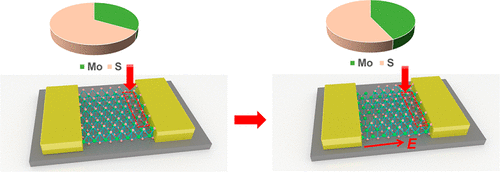Our official English website, www.x-mol.net, welcomes your
feedback! (Note: you will need to create a separate account there.)
MoS2 Memristors Exhibiting Variable Switching Characteristics toward Biorealistic Synaptic Emulation
ACS Nano ( IF 15.8 ) Pub Date : 2018-09-07 00:00:00 , DOI: 10.1021/acsnano.8b03977 Da Li , Bin Wu , Xiaojian Zhu , Juntong Wang , Byunghoon Ryu , Wei D. Lu , Wei Lu , Xiaogan Liang
ACS Nano ( IF 15.8 ) Pub Date : 2018-09-07 00:00:00 , DOI: 10.1021/acsnano.8b03977 Da Li , Bin Wu , Xiaojian Zhu , Juntong Wang , Byunghoon Ryu , Wei D. Lu , Wei Lu , Xiaogan Liang

|
Memristors based on 2D layered materials could provide biorealistic ionic interactions and potentially enable construction of energy-efficient artificial neural networks capable of faithfully emulating neuronal interconnections in human brains. To build reliable 2D-material-based memristors suitable for constructing working neural networks, the memristive switching mechanisms in such memristors need to be systematically analyzed. Here, we present a study on the switching characteristics of the few-layer MoS2 memristors made by mechanical printing. First, two types of dc-programmed switching characteristics, termed rectification-mediated and conductance-mediated behaviors, are observed among different MoS2 memristors, which are attributed to the modulation of MoS2/metal Schottky barriers and redistribution of vacancies, respectively. We also found that an as-fabricated MoS2 memristor initially exhibits an analog pulse-programmed switching behavior, but it can be converted to a quasi-binary memristor with an abrupt switching behavior through an electrical stress process. Such a transition of switching characteristics is attributed to field-induced agglomeration of vacancies at MoS2/metal interfaces. The additional Kelvin probe force microscopy, Auger electron spectroscopy analysis, and electronic characterization results support this hypothesis. Finally, we fabricated a testing device consisting of two adjacent MoS2 memristors and demonstrated that these two memristors can be ionically coupled to each other. This device interconnection scheme could be exploited to build neural networks for emulating ionic interactions among neurons. This work advances the device physics for understanding the memristive properties of 2D-material-based memristors and serves as a critical foundation for building biorealistic neuromorphic computing systems based on such memristors.
中文翻译:

MoS 2忆阻器具有向生物逼真的突触仿真的可变切换特性
基于2D分层材料的忆阻器可以提供逼真的离子相互作用,并有可能构建节能的人工神经网络,从而能够忠实地模拟人脑中的神经元互连。为了构建适用于构建工作神经网络的可靠的基于2D材料的忆阻器,需要系统地分析此类忆阻器中的忆阻开关机制。在这里,我们对通过机械印刷制成的几层MoS 2忆阻器的开关特性进行了研究。首先,在不同的MoS 2忆阻器之间观察到两种类型的直流编程开关特性,分别称为整流介导和电导介导的行为,这归因于MoS 2的调制/金属肖特基势垒和空位的重新分配。我们还发现,预制的MoS 2忆阻器最初表现出模拟脉冲编程的开关行为,但可以通过电应力过程将其转换为具有突然开关行为的准二元忆阻器。开关特性的这种转变归因于MoS 2 /金属界面处空位的场致团聚。额外的开尔文探针力显微镜,俄歇电子能谱分析和电子表征结果支持了这一假设。最后,我们制造了一个由两个相邻的MoS 2组成的测试设备并证明这两个忆阻器可以离子耦合。可以利用这种设备互连方案来构建神经网络,以模拟神经元之间的离子相互作用。这项工作为理解基于2D材料的忆阻器的忆阻特性提高了设备物理学,并为构建基于此类忆阻器的生物现实神经形态计算系统奠定了至关重要的基础。
更新日期:2018-09-07
中文翻译:

MoS 2忆阻器具有向生物逼真的突触仿真的可变切换特性
基于2D分层材料的忆阻器可以提供逼真的离子相互作用,并有可能构建节能的人工神经网络,从而能够忠实地模拟人脑中的神经元互连。为了构建适用于构建工作神经网络的可靠的基于2D材料的忆阻器,需要系统地分析此类忆阻器中的忆阻开关机制。在这里,我们对通过机械印刷制成的几层MoS 2忆阻器的开关特性进行了研究。首先,在不同的MoS 2忆阻器之间观察到两种类型的直流编程开关特性,分别称为整流介导和电导介导的行为,这归因于MoS 2的调制/金属肖特基势垒和空位的重新分配。我们还发现,预制的MoS 2忆阻器最初表现出模拟脉冲编程的开关行为,但可以通过电应力过程将其转换为具有突然开关行为的准二元忆阻器。开关特性的这种转变归因于MoS 2 /金属界面处空位的场致团聚。额外的开尔文探针力显微镜,俄歇电子能谱分析和电子表征结果支持了这一假设。最后,我们制造了一个由两个相邻的MoS 2组成的测试设备并证明这两个忆阻器可以离子耦合。可以利用这种设备互连方案来构建神经网络,以模拟神经元之间的离子相互作用。这项工作为理解基于2D材料的忆阻器的忆阻特性提高了设备物理学,并为构建基于此类忆阻器的生物现实神经形态计算系统奠定了至关重要的基础。











































 京公网安备 11010802027423号
京公网安备 11010802027423号